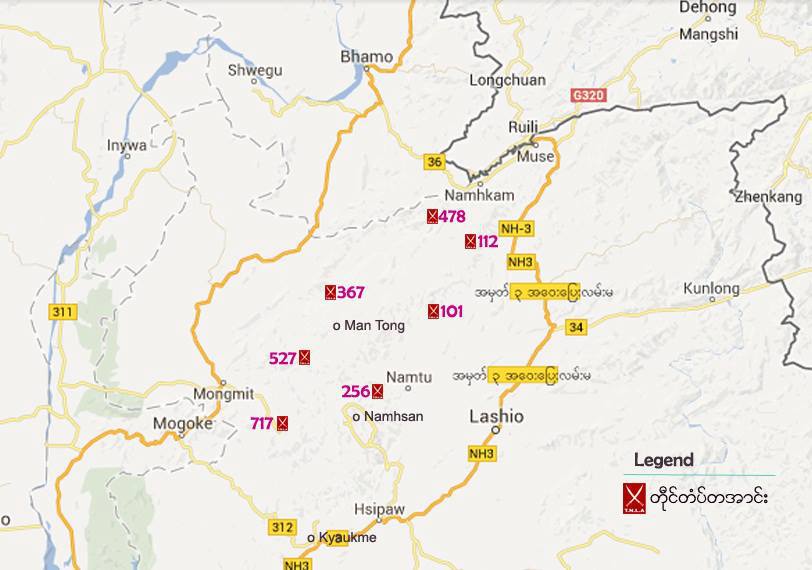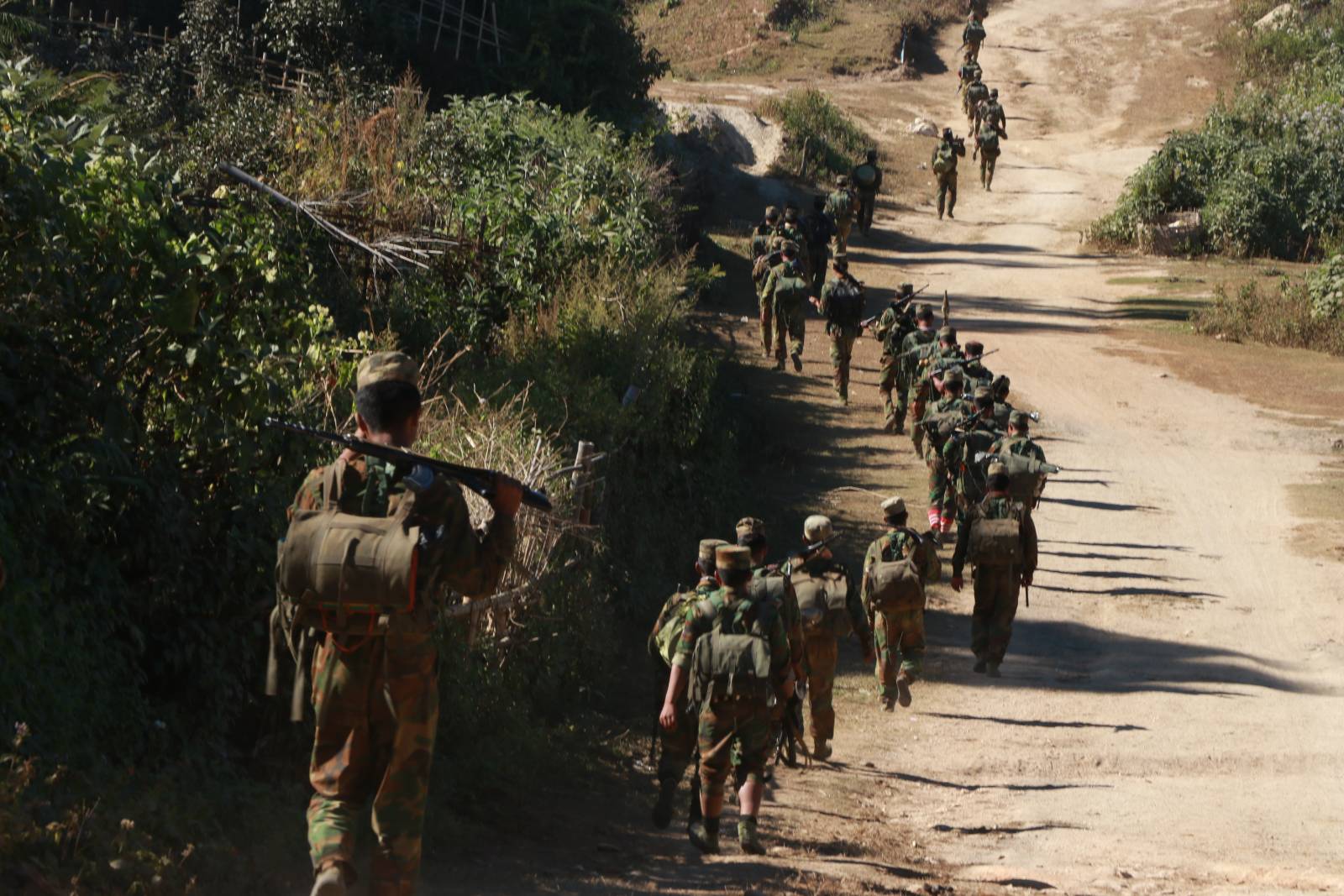As the junta’s military attempts to regain full control of border trade near Muse Town in northern Shan State, fighting with the deeply entrenched Ta’ang National Liberation Army (TNLA) is expected to intensify in the coming weeks as the junta sends in more troops and the TNLA pours more resources into defending the territory it controls, analysts say.
Fighting between the junta’s military and the TNLA—the armed wing of Palaung State Liberation Front—renewed in July soon after the ethnic armed organization (EAO) announced that it was increasing its military power to expand activities in territory it controls.
Clashes have continued since then and tensions are highest in three townships: Kutkai and Muse in northern Shan State and Mogoke in Mandalay Region.
At least a dozen heavy clashes broke out in the three townships this month, according to the TNLA. The clashes in Muse and Mogoke townships have been the most intense, said TNLA spokesperson Lt-Colonel Tar Aik Kyaw.
Since the February 1, 2021 coup, the TNLA has been focusing on strengthening its administration in the territory it controls. It has been working to maintain the rule of law, deliver health care and education, and improve the local economy, it said.
Since its inception in 2009, it has gradually acquired more strength and territory, but it has been unable to strengthen its administrative structure at the same rate since the coup.
A recent report from the International Crisis Group (ICG) highlighted that the 2021 coup has further strengthened the TNLA’s hand.

“Busy fighting on other fronts, the Myanmar military has largely withdrawn from the northern Shan State battlefield, enabling the group and its allies to gain territory and expel the RCSS from the area,” the report said, referring to the Restoration Council of Shan State.
However, its efforts to strengthen its administration appear to have weakened as it has had to focus on beefing up its military to resist the junta’s aggressive advances towards the territory it controls since July.
Conflict monitoring experts say that they do not see signs that the battles between the junta and the TNLA will fade away gradually. Instead, they expect protracted and fiercer battles with other EAOs expected to provide assistance to the TNLA.
“These clashes are still continuously breaking out as a part of the people’s spring revolution against the junta. Therefore, there is no reason to see them calm down within a few days or weeks,” said conflict analyst Than Soe Naing.
The clash that broke out between the TNLA and the junta’s military near Namtway Village in Kyaukme Township on July 10 was reportedly the very first since January 2022.
Clashes then spread to Muse Township on July 23 and continued breaking out until August 2 around Nar Than and Gaung Yar villages in Muse, near the border with China. Four junta battalions and pro-regime militias attempted to raid TNLA bases.
After the junta used a Mi-35 helicopter on August 10 to attack a TNLA base near Lashio, clashes stopped for a few days before resuming on August 19 in Lashio and Kutkai townships. Light skirmishes also broke out in Theinni Township.
Clashes between the TNLA and the junta’s military even broke out in Mandalay Region’s Mogoke Township this month. On September 10, junta troops raided a village south of Mogoke Town where TNLA troops were based.
In the TNLA’s fights against the junta’s military advances in Mogoke, the township-based battalions 1221 and 1223 of the People’s Defense Force (PDF) under the National Unity Government (NUG) claimed that they fought with the TNLA against junta troops.
The TNLA, however, has denied the PDF joined its fights against junta troops in Mogoke but admitted that the area is complex on the ground due to an overlap of PDF and TNLA forces.
“The fight actually happened alone with our group. However, as that area (Mogoke) is on the border between Mandalay Region and Shan State, the area where the (PDF) Mandalay Region group operates and the territory of our Brigade 2 may still have a connection,” Tar Aik Kyaw said.
However, he insisted that there was no formal cooperation between the PDF and TNLA—yet.
The TNLA’s political engagement with the post-coup resistance takes several forms. Notably, it does not interact publicly with the NUG. Instead, it works with the Ta’ang Political Consultative Committee (TPCC), a platform that ethnic Ta’ang politicians and civil society leaders formed after the coup to advance the goal of self-determination.
The TPCC is also part of the National Unity Consultative Council, a countrywide platform affiliated with the NUG, and the younger brother of the TNLA general secretary Tar Bhone Kyaw, Mai Win Htoo, is the NUG’s deputy minister for federal union affairs.
The TNLA has also granted refuge to a significant number of resistance activists, including Bamar and other ethnic people, who had to flee crackdowns.
The ICG report said that the TNLA has been training and equipping armed resistance groups formed since the coup and this support includes training NUG-backed PDFs, independent resistance groups and guerilla cells. It also facilitates weapons purchases and allows TNLA territory to be used for the movement of people, weapons and supplies.

“Some of the groups that the TNLA has trained and armed have returned to other conflict [areas], while others have been deployed on the fringes of TNLA territory, notably along the boundary between Shan State and Mandalay Region,” the report said.
A political analyst based in Shan State said that the TNLA still has to take steps, whether formal or informal, to engage the NUG, very carefully because of possible pressure of China.
“It cannot make its involvement in the spring revolution too obvious by cooperating with the NUG,” the analysts said. “It still has to go with covert moves as it is attempting to defend its area from being seized by the junta military,” he added.
China wields significant influence over ethnic armed groups based in northern Myanmar and during a decade of liberalization, China became a key international actor in the peace process between the government and the multitude of ethnic armed groups.
However, experts say that the junta’s military is preparing to escalate its advances and operations against the TNLA in northern Shan State as it wants to ensure the border trade route with China remains securely in its hands.
When the Irrawaddy asked Tar Aik Kyaw if he thought its allied groups, such as the members of Northern Alliance, would help resist it if the junta launched a more intense operation, he said that this is what happened during conflicts that broke out in the years before the coup.
He said that they do have northern alliance members, and also have political allies such as the members of the Federal Political Negotiation and Consultative Committee (FPNCC). The FPNCC was founded by seven ethnic armed groups, including the TNLA, with Beijing’s pressure in 2017, so that it could attend the then-government’s peace conference.
Tar Aik Kyaw said that the TNLA and its allies had cooperated in response to raids by the Myanmar military previously. He implied that if more intense operations were launched by the junta, its allies would not wait and watch from a distance.
With continuous clashes breaking out this week, thousands of residents in Shan State and Mandalay Region have fled their homes. On Monday, around 1,200 residents from several villages in Muse were displaced by fighting along the Muse–Namkham Highway when regime forces attempted to raid TNLA mountain bases.
On Tuesday morning, clashes were reported again in Muse Township on the Chinese border when TNLA Battalion 1 and a special commando unit raided a regime base near Sai Khaung Village. About 340 residents reportedly fled the fighting.
As fiercer attacks from the junta are expected in the coming weeks, activists and civil society groups working in the education and healthcare sectors in the Ta’ang territories have expressed deeper concerns about the impact on communities.
Conflict-monitoring analysts do not doubt the solidarity between the TNLA and its alliance.
U Than Soe Naing said that the Myanmar National Democratic Alliance Army, a member of the Northern Alliance, is also now stationed in some parts of Ta’ang territory and if further and more aggressive operations are conducted by the junta’s military, the Kachin Independence Army, also a member of the Northern Alliance, could also help the TNLA.
“The TNLA is indeed in control of a very large amount of territory, and due to the nature of its covert and unexpected moves, the more the junta fights, the stronger it will defend [its territory],” U Than Soe Naing said.
“We could even see the urban warfare in Muse,” he added.

















